The 20 Most Liked Posts on Instagram
By Gemma JoyceJul 19
Join us and boost your social media potential with our data-led event
Published April 18th 2017
Early on Monday morning last week (April 10), I had my first exposure to the now infamous United Airlines PR crisis which went on to become one of the biggest news stories of 2017 to date.
In case you need reminding, or somehow managed to miss what will probably go down as the biggest social media crisis of all time, here’s a brief recap.
The crisis started with a series of Tweets and Facebook posts from several passengers about the treatment of Kentucky Doctor David Dao while on United Express Flight 3411. Many of the posts included videos shot on mobile phones, which showed Dr Dao being violently removed from his seat and dragged from the plane.
What happened next will live long in the memory as an example of how not to deal with a crisis in the social media age. The outrage that followed and the misplaced responses from United catapulted the crisis to front page news across the globe and sparked discussion about airline overbooking policies that could impact the entire industry.
My first exposure to the incident came on Twitter, which is where most of the outrage has played out. While scrolling on my timeline I noticed that two people I followed had ‘liked’ Jayse David’s Tweet, which at the time of writing has been retweeted over 170k times.
@United overbook #flight3411 and decided to force random passengers off the plane. Here's how they did it: pic.twitter.com/QfefM8X2cW
— Jayse D. Anspach (@JayseDavid) April 10, 2017
When I first watched the video I was obviously shocked by what I saw. I was also surprised that it had only amassed around 2,000 retweets despite the Tweet timestamp showing that it had been published several hours before. Looking beyond Twitter, a Google News search of ‘United 3411’ revealed only a handful of articles covering the story. Things were about to change shortly, but at this point, the conversation appeared relatively quiet.
Like many people, I’ve paid close attention to the crisis over the last week, watching as the internet’s angry mob mobilized, while shaking my head at how United responded. With each new development, my thoughts came back to my first exposure on Twitter and the relative quiet before the storm. In today’s ultra-connected digital world, why did it appear to take so long for the story to grow?
Using Brandwatch Analytics, I collected all the conversation surrounding United on Twitter over the last week. By tracking how those first few hours played out, I hoped to learn more about how the story grew.
The first Tweets about the incident starting appearing online between 7-8PM EST on Sunday, April 9. Jayse David’s Tweet was published at 8.01PM EST.
The following chart plots the volume of Tweets about United during the first 48 hours. As you see there wasn’t any initial spike in conversation in the immediate hours following the incident.
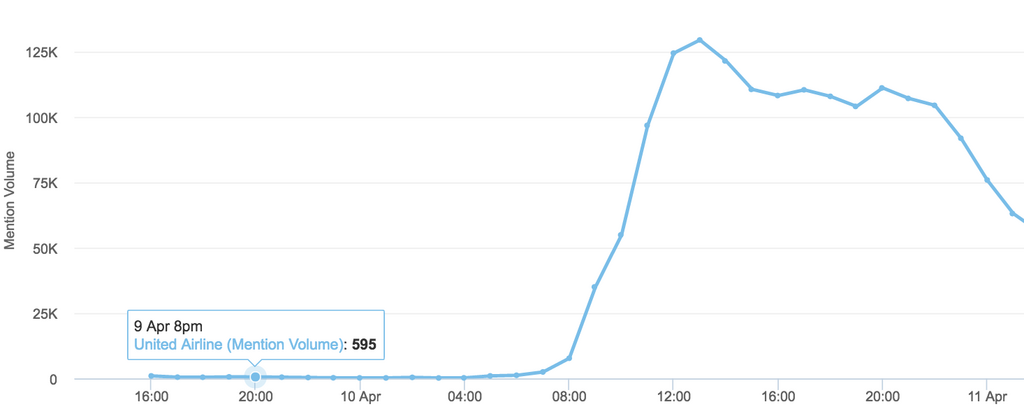
Most enterprises these days will use a social listening platform like Brandwatch Analytics for crisis detection. It’s one of the most commonly employed social listening use cases. Enterprises can monitor real-time conversations about their brand and set up alerts to inform them when there are changes of note.
The problem for United is that any alerts set up to track a spike in conversations wouldn’t have notified anyone that a situation was unfolding. In fact, conversations about United actually decreased in the following hours.

The timing of the incident might have played a big part in the relatively slow burn of conversation. While 8 pm isn’t exactly late in the day, it might just have passed by a large proportion of the English-speaking internet population who were logging off for the day.
It wasn’t until 5 am EST the next day when online conversations about United saw a spike that was out of the norm. A social listening alert set to detect increases in conversation might have just started to notice something was happening, nearly 10 hours after the first Tweets appeared.
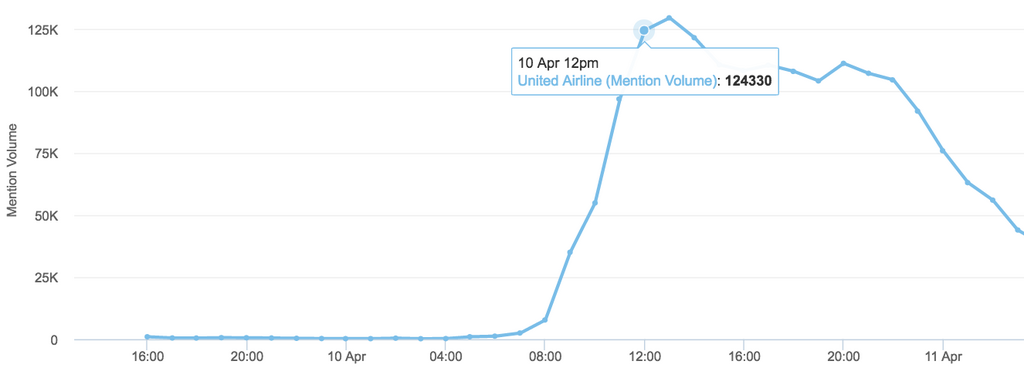
In just a two hours United would go from under 1,000 mentions an hour to nearly a quarter of a million mentions between 12-1 pm EST.
As @DonaldKim helpfully pointed out to United, they’d just made the front page of Reddit.
@united congrats you are on the front page of reddit
— Donald Kim (@donaldkim4real) April 10, 2017
By this point, the slow burn had turned into a small fire and it was about to turn into a raging blaze of negativity.
If United couldn’t have relied on a spike in overall volume to trigger an alert, they might have been able to rely on a change in sentiment to tell them that something was up — an increase in negative sentiment on social media demands attention.
The chart below shows the number of Tweets about United that were categorized as negative during this period.
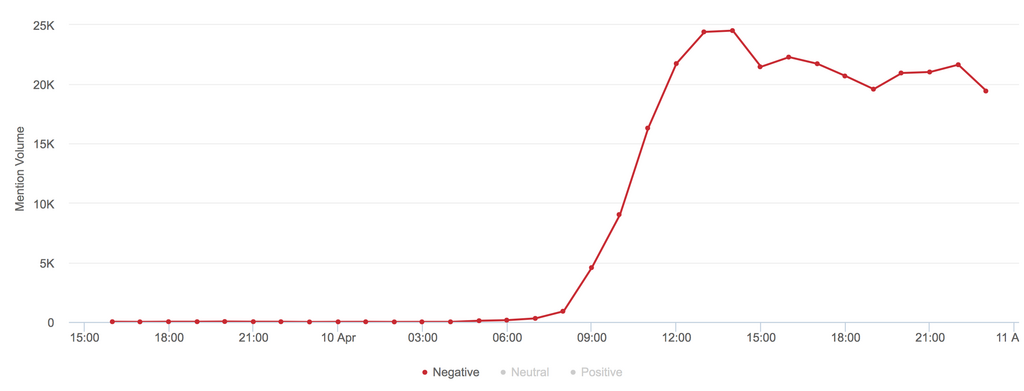
As you can see, there is no noticeable increase in the volume of negative mentions until 8 am the next day. A crisis alert relying on an increase in negative mentions wouldn’t have had the necessary spike due to the lack of total mentions in the early hours after the incident.
When the total volume of conversation doesn’t increase dramatically, net sentiment can offer a way to detect unusual shifts in sentiment. A greater proportion of negative mentions will result in net sentiment dropping, which might be enough to trigger a crisis alert.
For United, there was a change in net sentiment following the first series of Tweets.
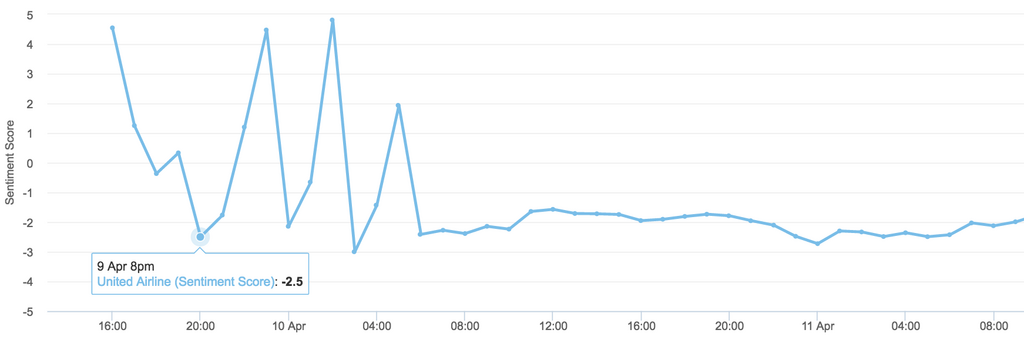
Net sentiment around the brand dropped to negative at 8 pm EST, however just two hours later net sentiment was back up to positive.
Further investigation shows that the incident on Flight 3411 was going head to head with an overwhelmingly positive story that involved their brand — Carter Wilkinson’s quest for a year’s free supply of Wendy nuggets.
If you get the 18 million RTs, we'll give you a free flight to take you to any @Wendys in the world in a city we serve. Good luck! https://t.co/igxnPg1JUF
— United Airlines (@united) April 8, 2017
Using topic analysis in Brandwatch we can see that at 10 pm, the conversation around United was being dominated by their promise of a free flight for Cater Wilkinson.

Sentiment analysis is undoubtedly a powerful tool for detecting crisis, but an out-of-the-box solution might not fully meet the needs of every business.
By looking at all the topics surrounding the incident we can see that ‘overbook’ is a common phrase. For most industries ‘overbook’ would be an irrelevant phrase and as such might not be flagged as negative by some sentiment analysis rules.
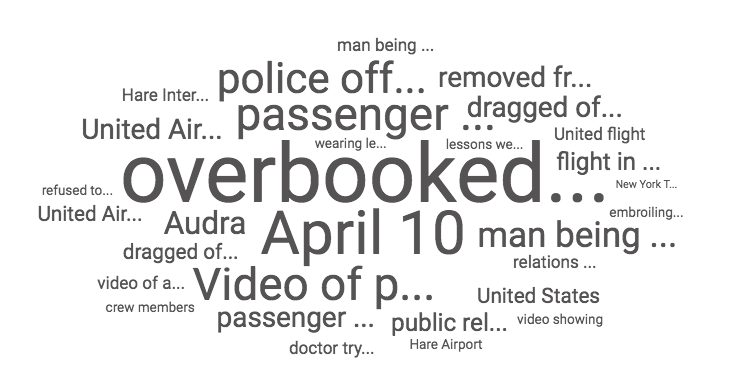
Brands in the market for social listening should be wary of platforms offering a one-size-fits-all approach to sentiment analysis. Brandwatch Analytics allows users to come up with their own rules to define sentiment on top of our extensive library of rules that already exist. Using Brandwatch Analytics, United would have been able to create a rule that ensured every incoming mention containing ‘overbook’, ‘overbooked’ or ‘overbooking’ was automatically categorized as negative.
This user-defined approach to sentiment analysis might well have helped trigger an alert that would have notified United the second the story started to take hold.
A user-defined approach is undoubtedly far superior that an out-of-the-box solution, but what about issues that might be hard to predict that don’t relate to known issues? ‘Unknown unknowns’ are a big issue for crisis detection as most alerts are only programmed to react based on what we can anticipate.
In these instances, it’s sometimes best to let the machines do the work. At Brandwatch, we have a feature called Signals that doesn’t require users to define what triggers an alert. Instead, our algorithms analyze all the mentions relating to your brand to identify anything unusual. This could be a spike in conversations around a certain topic (overbooking), the appearance of a new hashtag (#flight3411), or the increase in retweets from a certain individual (in this instance, the Tweet by @JayseDavid).
Of course, a lot of this article is theorizing about what United knew in those early hours. Even without a robust crisis alert system in place, the people manning the United Twitter account might have still been able to spot that something was building.
In fact, despite the lack of conversation spike, it hadn’t fallen outside of United’s field of vision. The official United Twitter account was responding to initial Tweets about the incident requesting more information and promising to investigate the situation.
Tyler, this is very concerning. Can you please provide the flight number and details via DM? Thank you. ^AD https://t.co/Y6hG6uklaR
— United Airlines (@united) April 9, 2017
Around four hours later, United put out their first official statement to the Louisville Courier-Journal.
Flight 3411 from Chicago to Louisville was overbooked. After our team looked for volunteers, one customer refused to leave the aircraft voluntarily and law enforcement was asked to come to the gate. We apologize for the overbook situation. Further details on the removed customer should be directed to authorities.
I must preface this by saying that I’m not an expert in crisis communications, so I don’t want to suggest to United Airlines, or anyone else that I know exactly how they should have responded. However, I think it would be fair to say that the early responses to the incident landed badly and helped escalate the crisis to front page news.
A lot of the internet’s collective anger was directed at the choice of the language used by United when commenting on the incident.
The first official statement on Twitter from CEO, Oscar Munoz, drew intense ire, particularly for the use of the phrase “re-accommodate”.
Hey @united , is this how you "re-accommodate" your passengers? pic.twitter.com/ZKKHOO97e4
— Jesse Modz (@jessemodz) April 11, 2017
This was the point where the conversation peaked with nearly a quarter of a million Tweets happening in the hour after the statement was published on Twitter.
Analyzing the common topics surrounding the incident before the statement, we can see that the most common phrases used by the public were “overbook” and “forcibly removed”.

This data analysis might have helped United understand which aspects of the conversation were important to address when releasing official statements. Despite the police’s involvement, there was no real conversation about ‘police brutality’. Instead, people were more fixated on the how the practice of overselling flights played a significant role in the events that unfolded, along with how the passenger was treated.
In the following days, United have released follow-up statements that addressed the key issues around overbooking that dominated the early conversation. There is a notable shift in the choice of language and sentiment used in Oscar Munoz’s second statement, which is a fairer reflection of the topics that were at the heart of the issue.
https://twitter.com/united/status/851875102769721344/
The discussion around overbooking has not been isolated to United. This incident has thrust overbooking practices into the collective consciousness, with many people calling for there to be an industry-wide review of the policies relating to overselling flights.
Nearly a week after the incident, European airline, easyJet, were also making front page news after two customers were removed from an overbooked flight.
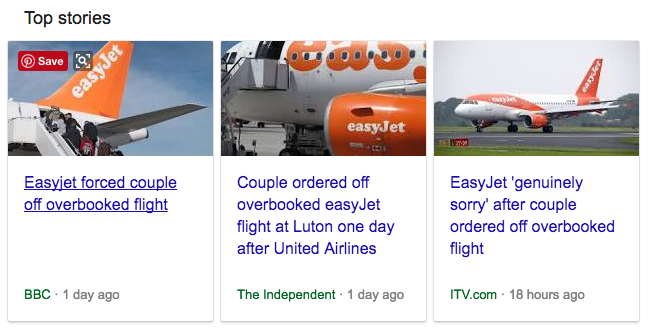
It was perhaps inevitable that the next airline to encounter an overbooking situation of a certain magnitude was likely to get dragged into the conversation. What happened to easyJet is a good reminder that a social media crisis can become a black hole drawing other brands towards it.
It’s an unfortunate part of crisis management that brands learn from mistakes — both their own and those committed by other brands. Perhaps the biggest lesson from the fallout of ‘United 3411’ is that brands can’t expect to brush past crisis communications with corporate spin. When they do respond, they need to put public’s interest first. They need to fully understand the important aspects of the conversation so they can effectively address the topics that really matter.
This is not our first post about United Airlines this year. Read our initial social data analysis of Flight 3411 and find out how leggings gave United their first taste of a social media crisis in 2017.
Offering up analysis and data on everything from the events of the day to the latest consumer trends. Subscribe to keep your finger on the world’s pulse.
Bring your social and marketing insights to life across your organization.

Existing customer?Log in to access your existing Falcon products and data via the login menu on the top right of the page.New customer?You'll find the former Falcon products under 'Social Media Management' if you go to 'Our Suite' in the navigation.
Brandwatch acquired Paladin in March 2022. It's now called Influence, which is part of Brandwatch's Social Media Management solution.Want to access your Paladin account?Use the login menu at the top right corner.